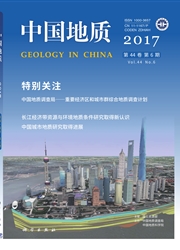

 中文摘要:
中文摘要:
巍山岩体位于云南西部哀牢山—红河断裂带附近,其主体岩性为二长斑岩和石英二长斑岩。LA-ICP-MS锆石U-Pb定年表明该岩体侵位于始新世,年龄为(38.5±0.6)Ma。巍山岩体为过铝质岩石,其铝饱和指数ASI(=Al2O3/(Ca O+Na2O+K2O),分子数)为1.09-1.44。所有样品具有高的K2O含量(4.50%-4.98%)和K2O/Na2O比值(1.10-1.41)。这些花岗闪长岩类呈现出埃达克质岩石的属性,例如高的Al2O3、Sr和低的重稀土(HREE)以及Y含量、Eu负异常缺失等。它们比云南西部同期的浅色过铝质侵入岩有着低的ISr和高的εNd(t)组成,暗示基性岩浆对该岩体的形成做出了贡献。岩石地球化学证据表明,该岩体最可能形成于幔源玄武质岩浆底侵诱发增厚地壳中沉积岩或者变质沉积岩发生了部分熔融。巍山岩体侵位年龄早于哀牢山—红河断裂带走滑过程(32-22 Ma),因此其形成可能与该断裂带的走滑无关。
 英文摘要:
英文摘要:
The Weishan pluton is located in western Yunnan, close to the Ailao Mountain- Honghe River fault zone. It comprises monzonite porphyry and quartz monzonite porphyry. The LA-ICP-MS zircon U-Pb dating suggests that the pluton was emplaced in Eocene, with the age of(38.5±0.6) Ma. The Weishan pluton is peraluminous, with ASI from 1.09 to 1.44. All the samples havehigh K2 O content(4.50 %to 4.98 %) and K2O/Na2 O ratios(1.10 to 1.41). The granitoids show adakitic affinities, such as high Al2O3,Sr, low HREE and Y content and the absence of negative Eu anomalies. The Weishan pluton has higher εNd(t) and lower ISrvalues than the coeval peraluminous plutons from western Yunnan, indicating the contribution of mantle material to the formation of the pluton. All the geochemical data imply that the Weishan pluton was likely derived from partial melting of the sedimentary or metasedimentary rocks of thickened crust, triggered by underplating of basaltic magmas. Due to the early emplacement age, the Weishan pluton was not likely related to the left-lateral displacement of the Ailao Mountain-Honghe River shear zone.
 同期刊论文项目
同期刊论文项目
 同项目期刊论文
同项目期刊论文
 Late Paleozoic WoniusiBasaltic Province from Sibumasu terrane: implications for the break-up ofeaste
Late Paleozoic WoniusiBasaltic Province from Sibumasu terrane: implications for the break-up ofeaste 期刊信息
期刊信息
